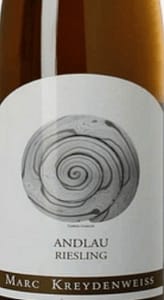The Tissot wines are classics in Jura. Labelled as André & Mireille (Stéphane’s parents), today Bénédicte and Stéphane are in charge, and the Tissot family is among a handful of producers who carry the torch for the whole region.
These are emotional wines, if we dear to use such an expression: If not the wines themselves are, they can at least create emotions. They are made with a deep passion for wine and environment, and it’s nothing industrial or mass-produced about them. The vines are cultivated in a biodynamic way, Demeter certified, it’s all completely natural, free of artificial chemicals, Tissot works with natural yeasts, and -needless to say- the sulphur levels are kept down to an absolute minimum. Because of the diversity of terroir they have decided to make many wines (around 30 different ones) in small quantities, to maintain their individuality.

Bénédicte and Stéphane Tissot
This week’s wines was tasted in our local wine club on Monday this week, along with other exceptional wines from Jura, several of them from Tissot, including a crémant, a late harvest dessert wine and the fortified “Macvin”. The choices could have been many, their Vin Jaune is also exceptional, but in the end I chose to highlight the Amphore.
The Savagnin Amphore is, as you might imagine, made from the savagnin grape variety and aged in amphora. The 20-25 year old vines were grown in soil with a high clay content, the maceration was made in amphoras where it also aged for 6 months, before pressing and maturing for 3 months, then bottled without filtration and without the use of sulphur.
Some words about the savagnin (blanc) is maybe justified: This is a grape from the sub-alpine regions of eastern France. It’s most famous for being the grape used in the typical “yellow wine” (vin jaune) aged under a blanket of flor yeast, just like in the sherry area (hence some similar aromas). But it’s used for a lot more, and over in the high-altitude vineyards of the Swiss Valais region it goes by the name heida, where it makes fresh and crisp dry white wines. There have been many attempts to link it to other varieties such as albariño and gewürztraminer, but all we know by now is that it has some association with (no, not the sauvignon, but…) the traminer varieties, and that it’s part of a whole family of savagnins.

Savagnin Amphore 2014 (Tissot)
Deep orange-brown, somewhat cloudy. Loads of skin contact character in aroma, mostly orange-peel, some nuts, mature apples, spices, some “wild” aromas on the same path as a good lambic. Good concentration, smooth in texture, and with smoky notes in the mouth and aftertaste.
Price: High (but still good value)
Food: Comté, other hard cheeses (such as gruyère), light meat, several types of Asian…














